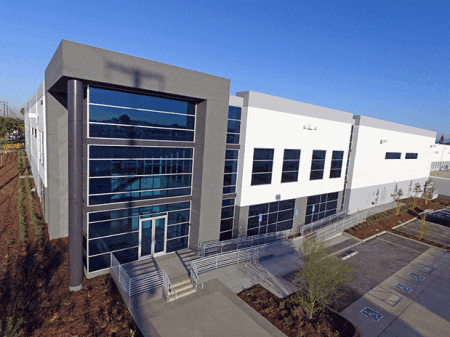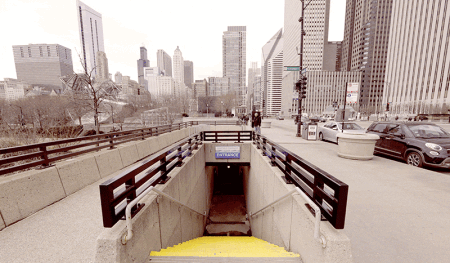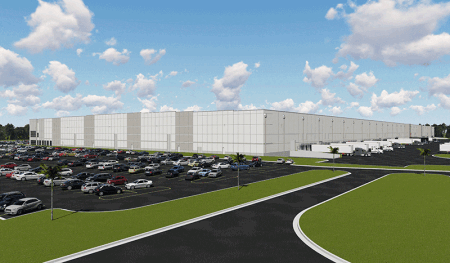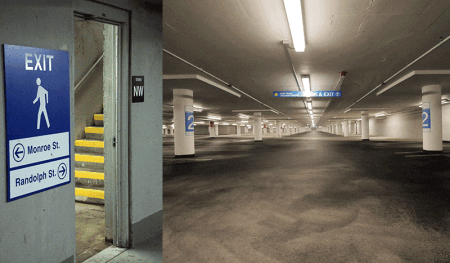Back in the mid-2000s, when e-commerce had not yet disrupted the retail sector and last-mile logistics was not the buzzword it is today, Boston-based private equity firm Cabot Properties amassed a portfolio of 20 million square feet (1.9 million sq m) of industrial space in various major U.S. cities with the expectation of leasing space to small service businesses.
“The users we were trying to attract would be your tire guy, your roof guy, or your electrical guy,” Cabot executive vice president Patrick Ryan explained during a panel on last-mile logistics at ULI’s 2017 Fall Meeting in Los Angeles. “They were easy to get because they were less price-sensitive regarding the rent, because they needed to be near the end user.”
That strategy seems almost quaint today. By the time Cabot sold the portfolio for $1.07 billion in early 2017, such properties had become a hot commodity, thanks to the phenomenal growth of e-commerce giants such as Amazon, Walmart, Wayfair, and others. Online sales are increasing at an annual clip exceeding 15 percent, and now reach close to $435 billion annually, according to the latest U.S. Department of Commerce figures. That, in turn, has created a seemingly insatiable need for warehouse space and loading docks that enable companies to cover the so-called last mile to customers’ doorsteps. Commercial real estate brokerage firm Cushman & Wakefield estimates that e-commerce now represents a quarter of all industrial leasing in the United States.
Among buildings that measure 700,000 square feet (65,000 sq m) and up, it is close to 30 percent.
Ben Conwell, senior managing director and head of Cushman & Wakefield’s national e-commerce practice group for the Americas and the moderator of the ULI panel, said that he spends a lot of time these days talking to both occupier and investor clients about the phenomenon. “Everybody wants to talk about the last mile,” he explained. “It is the hot topic, over the last couple of years, in the logistics real estate world.”
Signs of the surge in last-mile logistics are everywhere. Outside Miami, developer Foundry Commercial is erecting an Amazon warehouse so massive that it will span 20 acres (8 ha), plus another 20 acres for employee parking. In La Mirada, California, near Los Angeles, Overton Moore Properties recently completed a 194,000-square-foot (18,000 sq m) last-mile logistics facility, 14445 Alondra, on the site of a former Unocal Corporation plant, and quickly leased it to an unnamed retailer. In Chicago, commercial real estate services firm JLL is converting a portion of an underused urban parking garage into Millennium Chicago, a last-mile facility close to the affluent downtown retail market.
But even as online retailers have leased more space, their logistical needs have rapidly evolved. They remain eager to lease massive fulfillment centers with 800,000 to 1 million square feet (74,000 to 93,000 sq m) of space on the outskirts of metropolitan areas, even as the expansive acreage to build those sprawling facilities has become difficult for developers to find. But with customers increasingly expecting to receive their orders in hours instead of days, e-commerce companies also are searching for smaller facilities closer to densely populated areas, where they can pre-position inventory or quickly offload parcels from large trucks to smaller delivery vehicles that will rush them to their destinations.
“What Amazon is trying to do is have a delivery center close to every customer they care about,” explained Kenneth Boyer, chairman of the department of management sciences at Ohio State University, who was one of the early researchers to study the last-mile phenomenon.
Meeting those needs—and doing it at the accelerated pace demanded by the e-commerce market—has required developers to show boldness and ingenuity. To cut the turnaround time, some are building large centers on spec. They are racing to repurpose legacy industrial buildings close to population centers and are finding ways to work around those buildings’ imperfections, given that proximity to retailers’ customers is of overriding importance. And as they do all that, they are watching warily for the emergence of technological innovations that could disrupt the marketplace once more.
Location Is Crucial
The term last-mile logistics is something of a misnomer. Real estate research firm CBRE, which analyzed the location of last-mile distribution facilities opened over the past two years in the 15 largest U.S. metro areas, found that they typically were positioned between six and nine miles (10 to 15 km) from the population’s center point.
David Egan, CBRE’s global head of industrial and logistics research, said that based upon projections of where millennials will settle in the years to come, that “sweet spot” is unlikely to change much. And with more retailers entering e-commerce, he said, “the question is whether there’s going to be enough real estate to accommodate the need.”
Major e-commerce players already are searching for remaining sites big enough for the largest class of distribution centers, behemoths with 800,000 to 1 million square feet (74,000 to 93,000 sq m) of space that can accommodate massive inventories.
In Opa-Locka, Florida, ten miles (16 km) from Miami, developer Foundry Commercial is building a $180 million fulfillment center for Amazon on a 40-acre (16 ha) site with convenient access to U.S. Interstate 95, local arteries, and Miami International Airport’s freight operations. It is scheduled to be completed in 2018. Ford Gibson, Foundry’s managing director for development and investments, noted that Amazon sought out the developer, which originally had planned to erect several smaller buildings there, and provided a template.
“The facility is 850,000 square feet [79,000 sq m] on the footprint—that’s nearly 20 acres [8 ha],” Ford noted. “There are very few sites in Miami-Dade that can accommodate a building of that size. So we were in the crosshairs right away.” Availability of another 20 acres of parking for the massive workforce that an e-commerce fulfillment center needs was another attribute that made the site desirable.
“The demand for e-commerce has changed the playing field and caused a lot of disruption in the [real estate] industry,” Gibson explained. “With traditional industrial markets, they can go further out from major highways. They’re not as site specific. E-commerce wants to be close to major arteries, highways, toll roads.”
Huge last-mile facilities can serve as anchors for other development, according to Ernesto Cambo of CPF Investment Group, whose AVE Aviation & Commerce Center, a master-planned, mixed-use business park, is minutes away from the future Amazon facility. “Once you start moving thousands of people into an area, they need to have a place to deposit their paychecks, do their dry cleaning, and fill their prescriptions. You need to have a place to eat, whether it’s fast casual or a sub shop.”
Demand Drives Innovation
In the Seattle area, a young, technologically savvy population expects quick delivery of the items they order with a click of their mobile phones or tablets, but a tight real estate market makes it difficult to find sites for last-mile facilities. Logistics real estate firm Prologis has come up with an ingenious solution to maximize space. In April 2017, it broke ground on Georgetown Crossroads, a three-story, nearly 600,000-square-foot (56,000 sq m) fulfillment center, the first modern multistory warehouse erected in the Unites States since the advent of container shipping. Scheduled for completion in late 2018, the facility will have ramps to allow large trucks to drive up to second-floor loading docks, and a freight elevator to link the ground-floor docks to the third floor. In a press release, the company noted that “in cities with extremely limited development options, sometimes, the only way is up.”
The facility’s second floor is built to the same sort of specs normally used for a one-story center, Richard R. Kolpa, a Prologis vice president who handles the Seattle market, explained during the panel discussion on last-mile logistics at the Fall Meeting. “We have 135-foot [41 m] truck courts, fully designed for 53-footers [16 m] with cabs, and two ramps designed with turning radius for them.”
Georgetown Crossroads also will mix e-commerce with other industrial uses: the third floor has smaller spaces for offices and light industrial use, attributes that may attract engineering and design firms from Seattle’s aviation industry, Kolpa said.
Prologis’s project is being watched closely by other real estate developers and investors; and, if successful, multistory last-mile centers may become a hot trend, according to other participants in the ULI panel.
Thinking beyond the Truck
With the rise of same-day deliveries, there is increasingly intense competition to establish smaller, close-in facilities where products are transferred from big trucks to small vehicles. At the ULI panel, Overton Moore Properties chief executive Timur Tecimer described a 30,000-square-foot (2,800 sq m) last-mile facility in Greater Los Angeles, whose precise location he declined to disclose. “If you go there at eight in the morning, you’ll see 25 Priuses,” he explained. “They have their rack of goods, their deliveries, and they basically fill up those cars and they leave.” Such facilities do not need much space to store inventory: “They’re probably turning 30 times a month.”
Cushman & Wakefield’s Conwell, who before joining the real estate firm in 2015 worked as director of North America logistics real estate for Amazon Fulfillment Services, said in an interview that some of the smaller facilities are traditional cross-dock buildings—essentially, transfer stations where pallets of goods would be transferred from one truck to another, without any storage of inventory. Such buildings, once out of favor, are now increasingly sought by e-commerce companies and have become popular with institutional investors, he said.
Conwell said that such buildings generally measure between 40,000 and 100,000 square feet (3,700 to 9,300 sq m) in size, though they can be larger in certain locations. Their key characteristic is low coverage—that is, the structures take up a smaller percentage of the lot than typical industrial buildings, which provides room for parking and maneuvering trucks and storing trailers until they can be loaded.
As recently as a few years ago, occupiers were so eager to get such locations that they often would take them “as is” and simply cope with their imperfections. But as developers and institutional investors have discovered the market, more buildings are being built on spec. “That can mitigate the need to settle for an existing building,” Conwell said. Even so, “the growth of this demand has been so strong and quick that even waiting a year or more to land a last-mile node in a highly desirable area can be too much for some occupiers to accept.”
E-commerce is also creating a demand for even smaller, closer-in facilities, which Conwell calls last depots or terminals, to serve as the last touchpoint for orders that begin their journey at a massive distribution center. Such facilities may be as small as 20,000 square feet (1,900 sq m), and are situated in small buildings or in a portion of a multitenant building.
Creating a Versatile Warehouse
The need for last-mile logistics has led some developers to scrape sites that once held shopping malls or other physical retail, or to convert low-grade office space into warehouses. But in Chicago, real estate services firm JLL has come up with an innovative play for investors who hold a lease to a city-owned parking garage—repurposing a portion of it as a last-mile warehouse. JLL says it is the first such conversion in the United States. The Millennium Chicago last-mile facility, located at Michigan Avenue and Randolph Street in the city’s central business district (CBD), will be within 15 minutes of nearly 230,000 city residents, according to the project’s website. Keith Stauber, a JLL managing director, said that the existing building is well suited for such a makeover. “It’s one big, wide horizontal underground garage,” he explained. “We don’t have significantly pitched floors like traditional urban garages.”
After inventory on trucks is unloaded at docks on the lower level of Randolph, cars and vans will be able to drive into the structure to pick up packages for direct delivery. “We’ve only got eight-foot [2.4 m] ceilings, but [when] you figure how quickly product is going to move in and out of this space, you don’t need to put it up on big racks,” Stauber said.
While Millennium Chicago, which may be completed in 2019, will be advantageous for e-commerce, Stauber said that JLL envisions attracting other occupiers, ranging from food distribution for the city’s hotels and restaurants to fulfillment by brick-and-mortar retailers in Chicago’s CBD. “We’re right there at the doorstep of Michigan Avenue,” he said. “As retailers retool and think about how they want to interact with their customers, they may want to have smaller inventory in the store, and let us hold it for them.” By relying upon Millennium Chicago, retailers could convert space in their stores to create in-person experiences for shoppers, while still providing quick delivery turnaround to compete with e-commerce.
The project is an example of how last-mile logistics is continually evolving. Developers and investors, meanwhile, are watching for potential game-changing developments, such as drone delivery and Walmart’s testing of a service in which workers would be allowed into homes by smart locks, so that they could deliver packages and even put food in customers’ refrigerators while they are at work. Amazon is piloting an in-home delivery system for its Amazon Prime customers as well.
As Conwell explained during the ULI panel, the only unchanging factor in last-mile logistics is continued growth. “We only know this is going to get bigger,” he said.









